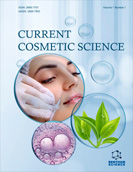Abstract
Background: The movement of conscious consumption is growing rapidly. The idea of leaving behind synthetic products and substances that generate waste from their production to their final disposal grows and widens the gap between the old capitalist paradigm and the concept of naturism. It includes environmental awareness, taking care of our body, and the conscious choice of what we eat, wear, and use in daily life, including cosmetic products.
Objective: This study aimed to explore a new paradigm of formulation and consumption. A group of parabens was selected, and their replacement with preservatives approved for natural cosmetics was proposed. Some of the risks associated with the consumption of parabens in food, cosmetics, and medicines, were also examined. Moreover, the advantages and disadvantages of preservatives for the product and consumer were also discussed.
Methods: For data collection, publications in indexed journals were searched, with the keywords: parabens, endocrine disrupting chemicals, and skin conditions related to the use of parabens.
Results: Recent studies have reported that by using parabens in skin products, we create an imbalance in the skin flora. This preservative decreases the defense capacity of our first immune line and causes disorders that lead to irritation, rosacea spots, oiliness, and sectorized peeling. Furthermore, parabens are exogenous substances that alter the functions of the endocrine system and can cause adverse health effects.
Conclusion: In Argentina, compounds from the paraben family are used by many brands as preservatives, which are dangerous to health and the environment. Therefore, a conscious, sustainable, biodegradable, and cruelty-free alternative is needed to replace parabens in cosmetics.
[http://dx.doi.org/10.1002/jat.3917] [PMID: 31903662]
[http://dx.doi.org/10.1002/jat.978] [PMID: 15211609]
[http://dx.doi.org/10.1006/taap.1998.8544] [PMID: 9875295]
[http://dx.doi.org/10.1016/S0960-0760(01)00174-1] [PMID: 11867263]
[http://dx.doi.org/10.1016/S0278-6915(01)00073-4] [PMID: 11696396]
[http://dx.doi.org/10.1002/jat.860] [PMID: 12210538]
[http://dx.doi.org/10.1002/jat.886] [PMID: 12518336]
[http://dx.doi.org/10.1016/j.envres.2016.07.011] [PMID: 27504873]
[http://dx.doi.org/10.1016/j.mce.2018.03.014] [PMID: 29596967]
[http://dx.doi.org/10.2174/1570159X17666190726112101] [PMID: 31362658]
[http://dx.doi.org/10.1016/j.jsbmb.2011.05.002] [PMID: 21605673]
[http://dx.doi.org/10.1177/1559325815598308]
[http://dx.doi.org/10.2174/0929867324666171009121001] [PMID: 28990514]
[http://dx.doi.org/10.1016/S0045-6535(00)00196-X] [PMID: 11272914]
[http://dx.doi.org/10.3390/ijerph14030334] [PMID: 28327540]
[http://dx.doi.org/10.1007/s11356-019-07388-w] [PMID: 31873886]
[http://dx.doi.org/10.1111/jocd.12989] [PMID: 31106952]
[PMID: 16036114]
[http://dx.doi.org/10.1371/journal.pone.0231078] [PMID: 32339170]
[http://dx.doi.org/10.1021/acs.est.6b04302] [PMID: 28318231]
[http://dx.doi.org/10.1289/ehp.0901560] [PMID: 20056562]
[http://dx.doi.org/10.1038/jes.2013.69] [PMID: 24149971]
[http://dx.doi.org/10.1021/es400510g] [PMID: 23469879]
[http://dx.doi.org/10.1016/j.envint.2019.105103] [PMID: 31470218]















